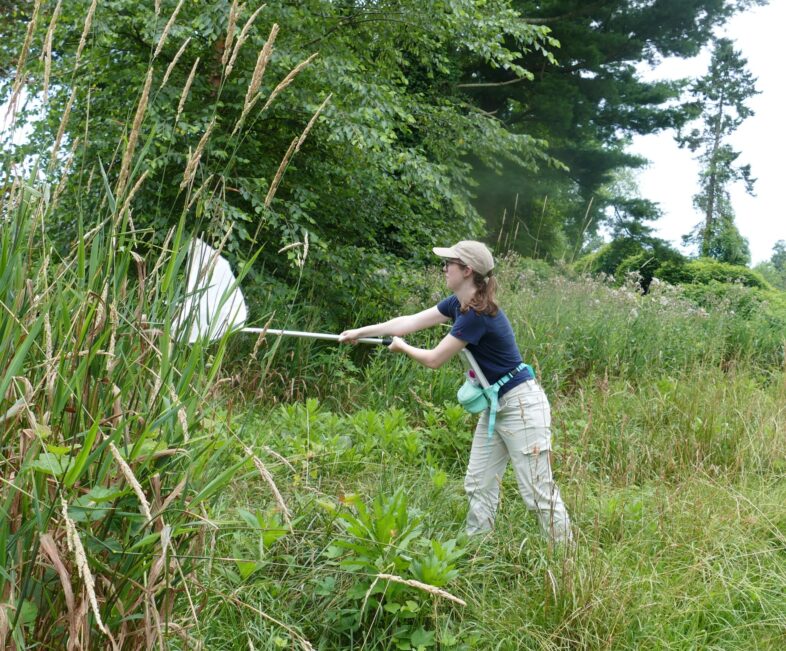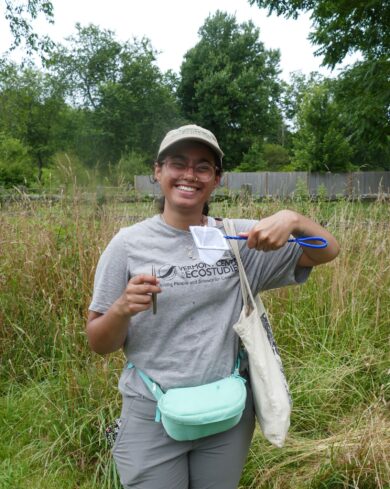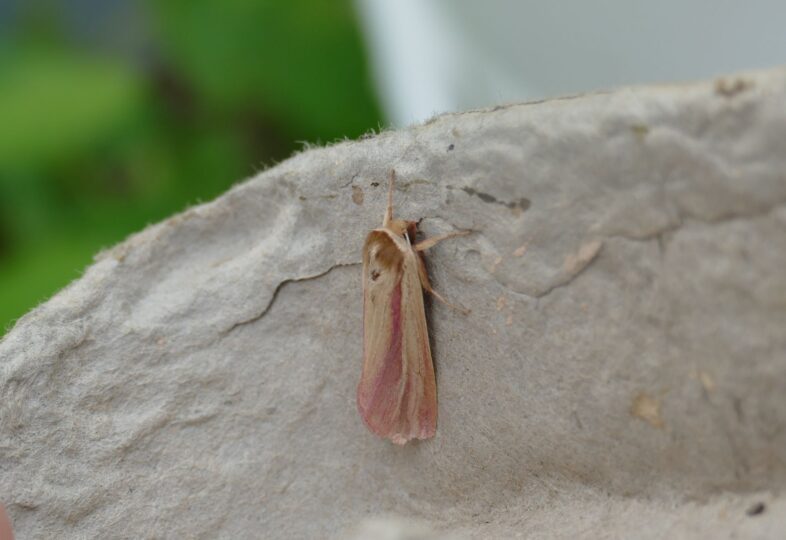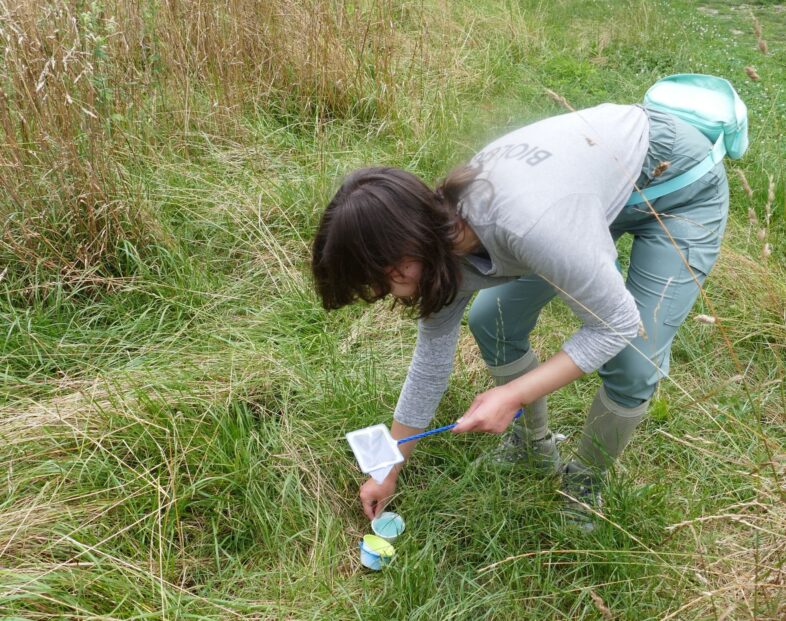
VCE Summer Field Ecology Intern Zoey Pickett sweeps for invertebrates in the tall grass.
VCE has been busy this summer! In addition to asking cutting-edge ecological questions, we are also helping colleagues tackle their conservation problems. Many land managers ask themselves, “How well are we doing in our restoration?” In these cases, systematic monitoring and VCE’s expertise in this area can be really helpful.
This summer, VCE conservation scientist Dr. Desiree Narango and the rest of the technician team have been helping Connecticut Audubon with a key wildlife preserve in Westport, Connecticut. The Smith Richardson Wildlife Preserve is an approximately 30-acre property that used to be a Christmas tree farm until it was gifted to Connecticut Audubon. Since that time, the organization has recognized this site’s potential for preserving sensitive wildlife in one of the nation’s most developed areas. Westport is exactly what you would imagine coastal Connecticut to look like: very suburban, with high-valued land and development near the shore. But nestled within this significantly developed landscape is this gem of a wildlife preserve. It’s a beautiful oasis that provides a habitat for breeding birds, insects, and mammals while also serving as a recreational area for trail walks, running, and just enjoying nature.

VCE Interdisciplinary Intern Gita Yingling pauses while removing invertebrates from a net.
But the site needs a lot of love, too. Invasive plants are rampant, outcompeting native species. The deer population is extremely high, reducing plant diversity and complexity. There is also suspected pollution runoff from the surrounding suburban neighborhood. Recently, Connecticut Audubon developed a comprehensive restoration plan for the Smith Richardson Wildlife Preserve with an ecological designer, which included removing invasive plants and vines such as mugwort, mile-a-minute, and wineberry and replacing them with native species. Their plan also includes using herbicides to reduce competition from invasive plants, as well as seeding and planting native plants to increase floral diversity and tree canopy.
But before Connecticut Audubon undertakes such an ambitious restoration project and evaluates its impact, it must develop a solid baseline of what biodiversity they are currently supporting. VCE is working with the Connecticut Audubon land managers to help provide that information from the insect perspective. Insects are ideal ecological indicators to monitor restoration success because they respond to changes at small spatial scales (like 30-acre preserves) and respond much quicker than larger wildlife like birds or mammals.
In July, Dr. Narango and an intrepid team of interns, Zoey Pickett, Gita Yingling, Pia Carmen, and Eli Byington, traveled the 2.5 hours to Westport to complete our summer Smith Richardson surveys. Our monitoring consisted of three main data collection techniques:
- We conducted systematic transect surveys to document butterflies and bumble bees. We can document most species using photographic methods rather than lethal collection. With these methods, we can determine butterfly and bumblebee diversity, the probability of detection, and what flowers they interact with.
- We also used bee bowls. These small yellow, blue, and white painted bowls attract small bees, like sweat bees, for collection. This technique is ideal for capturing small, nondescript bees that are hard to detect and must be identified under a microscope.
- We also installed bee boxes with plexiglass panels to observe what mason bees, other cavity-nesting bees, and wasps are on the property. We are testing this new technique to see if bees colonize these boxes and whether we can use the boxes for population monitoring.

One of several new bee boxes the team deployed during their visit.
Our July trip was tremendously successful! Although the floral diversity was pretty low (because of the aforementioned invasive plants), we still had a variety of interesting observations. We documented the presence of Bombus fervidus, the Golden Northern Bumble Bee, a species we had originally discovered at the site in May when we observed a queen foraging on one of their unrestored parcels. On this July trip, we found a worker Bombus fervidus approximately 200 meters from where we first observed the queen, suggesting that she was successful in initializing the colony. However, interestingly, we did not observe the worker on our baseline transect surveys. We observed it on one of Audubon’s tiny (12m x 12m) restoration plots that they had already started. Our worker bee was foraging on some Wild Bergamot (Monarda fistulosa) planted just a year prior, suggesting that Connecticut Audubon’s actions are already benefitting a state-threatened species!
We found several other species of pollinators, including a diverse array of butterflies, an encouraging number of Monarchs, and some nesting Litigated Furrow Bees. We’ll have a much better idea of the pollinator diversity once we’ve examined our specimens under the microscope.

The Pink-streaked Moth is a sand plains specialist that’s state-listed in Connecticut.
We also observed some interesting non-target wildlife. Although we were not surveying birds, we witnessed nesting activity of Orchard Orioles and Field Sparrows, both uncommon species that were exciting to document. Dr. Narango also can’t help but do some mothing wherever she goes, so she also set up a UV light on two nights for fun. In addition to documenting a wide variety of beetles and other insects, she also found a state-listed moth species: the Pink-streaked Moth. This moth is a sand plains specialist species whose host plants include several native switchgrasses. The presence of this moth near the coastal area suggests that the Smith Richardson Preserve might be an important stronghold for this species.

VCE Interdisciplinary Intern Pia Carman gathers invertebrate samples.
These are just a few of the exciting findings for this whirlwind trip. Our interns shared some of their favorite sightings and findings:
Zoey: I was interested in seeing how Connecticut Audubon is restoring the area. This visit was a perfect example of how an ecosystem is connected: native plants support pollinators and other insects, ample insects provide birds with a stable diet, and birds can help disperse native plant seeds. All aspects of the ecosystem are connected, meaning all restoration is beneficial on multiple levels!
Gita: My visit to the preserve alerted me to how rapidly an invasive species can spread across an area. It’s one thing to be aware of how invasive species work, but another thing entirely to see its dispersal in action, as we did with the Spotted Lanternfly (Lycorma delicatula). The abundant and unfortunate presence of these easily identifiable red, black, and white insect nymphs is a reality of our changing climate. The Spotted Lanternfly was only first observed in Connecticut in 2018 but has already spread rapidly across the state. Awareness is the first step to improvement, especially in the Smith Richardson Preserve, which is such a promising site both ecologically and recreationally. Restoration is key to fighting off unwanted invasive species in these vulnerable areas. With Connecticut Audubon’s restoration initiative, we hope to see a decrease in both invasive plant and insect species that outcompete natives.
Pia: It was fascinating to see how the composition of plants in the preserve connected to the composition of pollinators; an ecosystem only a couple hours away had a fundamentally different landscape. Some species were very familiar sights, such as an abundance of Monarchs on Common Milkweed, while others were unfamiliar to me, like Lone Star Ticks. While ticks are relatively common in Vermont, it was intriguing to see how a different ecosystem affects which species you find and which ones you don’t, with ticks only being one example. (I found American Dog Ticks and Lone Star Ticks but was surprised not to find any Blacklegged Ticks during this trip!)
Eli: This trip definitely helped me gain some insight into the different methods of insect data collection. I was surprised by how quickly insects were attracted to the bee bowls within the three days at the site. Since the bee boxes are new installations, I didn’t know what to expect to see. I was excited to witness insect colonization in progress at several sites.
As you can see, we had great success visiting our southern neighbors in Connecticut. We’ll be making another visit in September to see what kinds of pollinators are visiting the meadows during that time period. Then, we’ll analyze and write up our findings, looking forward to all the restoration happening at this incredible site. Stay tuned!
